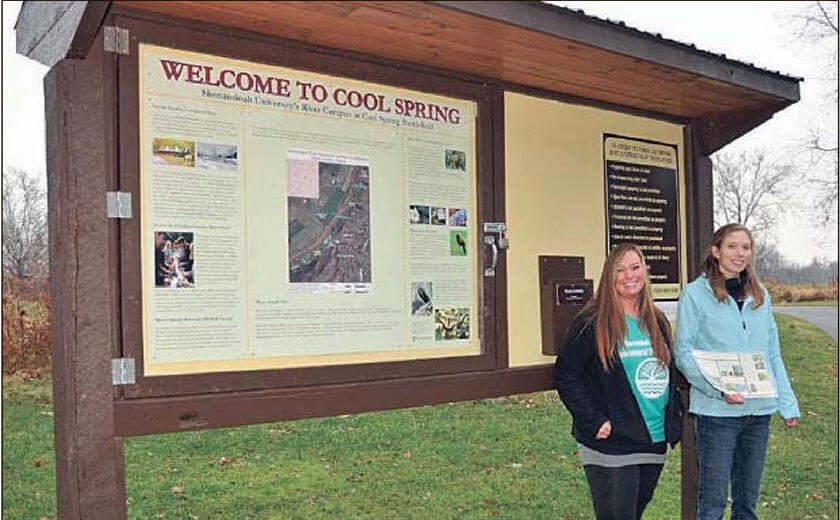Photo courtesy of Shenandoah University
This new kiosk, at the start of the walking trail on Shenandoah University’s River Campus at Cool Spring Battlefield in Clarke County, offers a map of the area and information on the natural world to see along it. The kiosk was created by students in SU’s environmental studies program, including Ashley Landes (left) and Amy Lewis, to educate local residents on the wonders of the natural world around them.
Preservation, said Shenandoah University graduate Amy Lewis, happens at the local level.
So, letting local people know what they have is the first step to protecting a natural environment.
Lewis, and other members of the environmental studies program at SU, last year picked a project on SU’s River Campus at Cool Spring Battlefield to carry out that effort. The River Campus is along the Shenandoah River off Route 7 in Clarke County.
In April, 10 undergraduate students in the program began to design an informational kiosk as a way to welcome the public to use the almost 200-acre campus that is also a Civil War battlefield.
A service-learning project, to connect the community to the environment, is a requirement of the program. Students are challenged to meet a local need, based on what they have learned in previous courses.
Since its inception in 1995, students have helped protect the Abrams Creek Wetlands; developed the “Winchester & Frederick County — Naturally,” brochure; prepared interpretive signs for the Redbud Run Greenway (watershed management project) and promoted linear parks in the Shenandoah Valley region.
“It’s something that Woody stresses,” River Campus site manager Gene Lewis said of Woodward Bousquet, SU’s professor of environmental studies and biology.
Lewis and staff member Ben Sawyer took on the task of refurbishing the kiosk to incorporate the new information.
“We wanted to draw people’s attention to it,” said Ashley Landes, of Frederick County, a senior in the environmental studies program, of the Cool Spring campus.
The property, donated to SU in 2013 by the Civil War Trust, is rather an unknown quantity to the community, said Lewis, who graduated in June and is now an intern at the Smithsonian Conservation Biology Institute in Front Royal.
It is open to the public, from dawn to dusk, for walking, hiking, bird-watching, cycling and nature study.
The information on the kiosk, along with its trail maps, is planned to help people enjoy their experience on the campus.
A printed trail guide directs visitors along the 1.2-mile paved walking trail with nine specific stops.
The kiosk panels explain some of the things that may be seen, including bat-roosting boxes and the heron rookery near Parker Island on the Shenandoah River.
Lewis, a native of New Jersey who is aiming to be a veterinarian, said she had never seen a heron rookery.
The kiosk is located at the point where the paved trail begins, next to the main parking lot.
The trail map directs visitors across the rolling terrain, along the banks of the river, but avoids some of the steeper parts of the property to make it easier for families with children to enjoy.
Along the way, visitors can also see a pair of informational panels explaining the Battle of Cool Spring, fought over the ground in the summer of 1864 as Federal troops chased Confederate Gen. Jubal Early back to the Shenandoah Valley after his raid on Washington, D.C.
Having a property like the River Campus is a definite plus for learning about the natural environment, according to both Lewis and Landes.
“We’re some of the first students to get to explore the property,” said Landes. “It’s exciting. We’ve gotten to test the waters!”
Creating the kiosk gave them a lot of satisfaction, she said. Lots of people over the years will stop and learn from it.
“That’s a lot better than writing a paper that only the teacher sees,” she noted.
— Contact Val Van Meter at vvanmeter@winchesterstar.com
By VAL VAN METER The Winchester Star
REPRINTED WITH PERMISSION OF The Winchester Star




